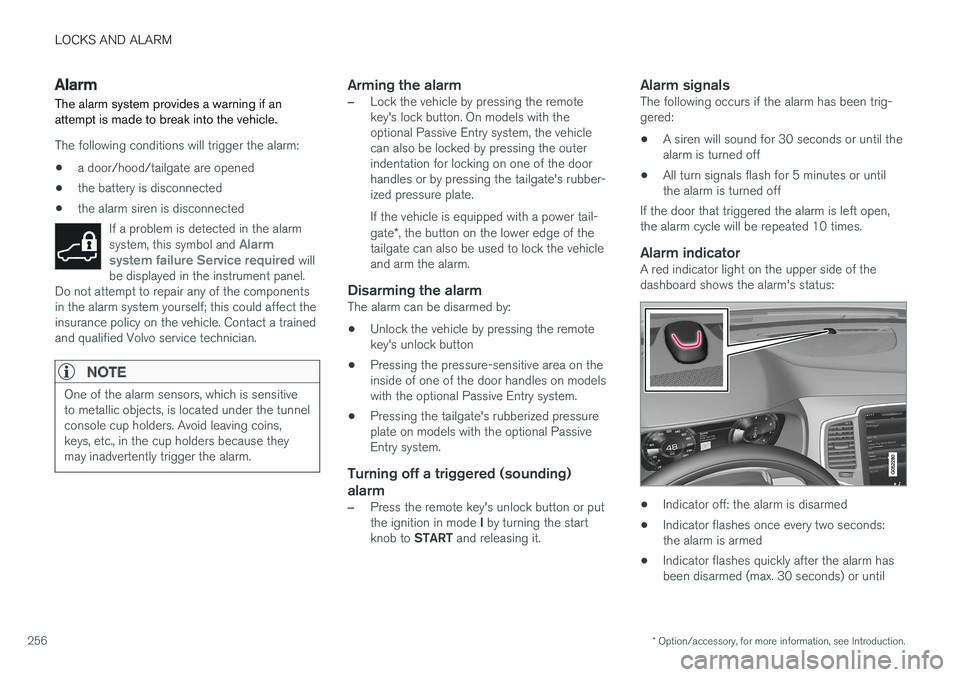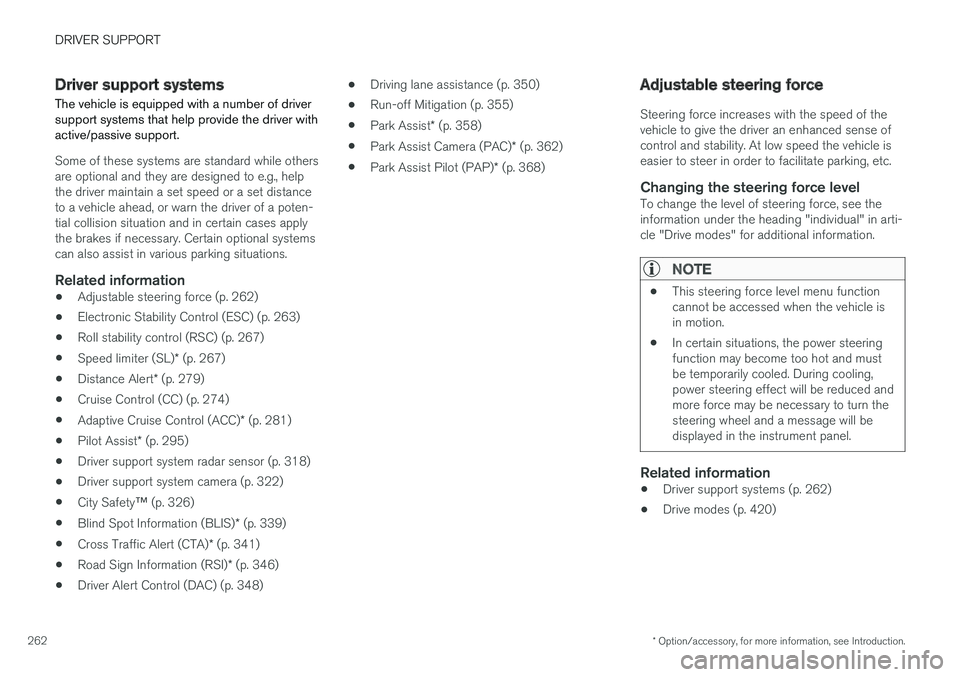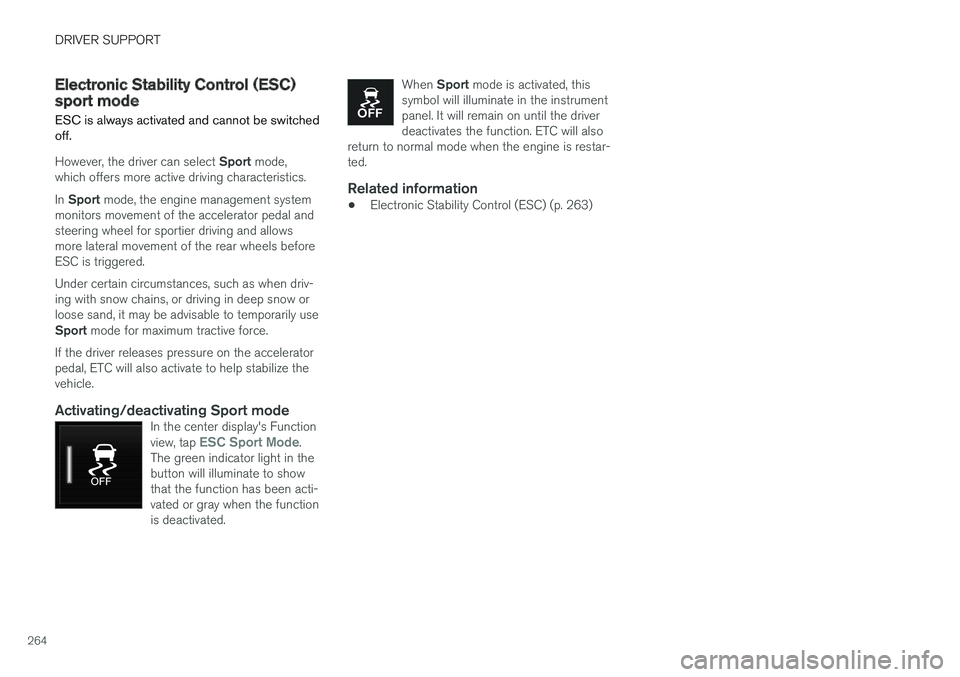display VOLVO XC90 TWIN ENGINE HYBRID 2017 Owners Manual
[x] Cancel search | Manufacturer: VOLVO, Model Year: 2017, Model line: XC90 TWIN ENGINE HYBRID, Model: VOLVO XC90 TWIN ENGINE HYBRID 2017Pages: 584, PDF Size: 14.2 MB
Page 256 of 584

||
LOCKS AND ALARM
254
Related information
•Locking/unlocking the tailgate (p. 249)
•Using the glove compartment (p. 221)
•Navigating in the center display's views(p. 43)
Locking/unlocking with thedetachable key blade
The detachable key blade can be used to e.g.,unlock the driver's door from the outside if, forexample, the remote key's battery is weak.
Unlocking
Pull out the driver's door handle as far aspossible to access the lock cylinder.
Remove the key blade from the remote keyand insert it into the lock cylinder.
Turn it clockwise 45 degrees so that the keyblade points straight rearward.
Turn the key blade back 45 degrees to itsoriginal position. Remove the key blade fromthe lock cylinder and release the door han-dle.
5.Pull the door handle again to open the door.
> This will trigger the alarm.
Lock the door in the same way, but turn the keyin step 3 counterclockwise.
Turning off the alarm
Backup key reader under the tunnel console cup hold-ers
To turn off the alarm:
1.Place the remote key in the cup holder (onthe key symbol) in the tunnel console (seethe illustration).
2.Turn the start knob to START and release it.
> The start knob will return to its originalposition and the alarm will be turned off.
Locking
If necessary, the vehicle can be locked by insert-ing the detachable key blade into the lock cylin-der in the driver's door.
Each of the other doors has a lock mechanismthat must be pressed in using the key blade sothat the door cannot be opened from the outside.The doors can still be opened from the inside.
Page 258 of 584

LOCKS AND ALARM
* Option/accessory, for more information, see Introduction.256
Alarm
The alarm system provides a warning if anattempt is made to break into the vehicle.
The following conditions will trigger the alarm:
•a door/hood/tailgate are opened
•the battery is disconnected
•the alarm siren is disconnected
If a problem is detected in the alarmsystem, this symbol and Alarmsystem failure Service required willbe displayed in the instrument panel.Do not attempt to repair any of the componentsin the alarm system yourself; this could affect theinsurance policy on the vehicle. Contact a trainedand qualified Volvo service technician.
NOTE
One of the alarm sensors, which is sensitiveto metallic objects, is located under the tunnelconsole cup holders. Avoid leaving coins,keys, etc., in the cup holders because theymay inadvertently trigger the alarm.
Arming the alarm
–Lock the vehicle by pressing the remotekey's lock button. On models with theoptional Passive Entry system, the vehiclecan also be locked by pressing the outerindentation for locking on one of the doorhandles or by pressing the tailgate's rubber-ized pressure plate.
If the vehicle is equipped with a power tail-gate*, the button on the lower edge of thetailgate can also be used to lock the vehicleand arm the alarm.
Disarming the alarm
The alarm can be disarmed by:
•Unlock the vehicle by pressing the remotekey's unlock button
•Pressing the pressure-sensitive area on theinside of one of the door handles on modelswith the optional Passive Entry system.
•Pressing the tailgate's rubberized pressureplate on models with the optional PassiveEntry system.
Turning off a triggered (sounding)
alarm
–Press the remote key's unlock button or putthe ignition in mode I by turning the startknob to START and releasing it.
Alarm signals
The following occurs if the alarm has been trig-gered:
•A siren will sound for 30 seconds or until thealarm is turned off
•All turn signals flash for 5 minutes or untilthe alarm is turned off
If the door that triggered the alarm is left open,the alarm cycle will be repeated 10 times.
Alarm indicator
A red indicator light on the upper side of thedashboard shows the alarm's status:
•Indicator off: the alarm is disarmed
•Indicator flashes once every two seconds:the alarm is armed
•Indicator flashes quickly after the alarm hasbeen disarmed (max. 30 seconds) or until
Page 264 of 584

DRIVER SUPPORT
* Option/accessory, for more information, see Introduction.262
Driver support systems
The vehicle is equipped with a number of driversupport systems that help provide the driver withactive/passive support.
Some of these systems are standard while othersare optional and they are designed to e.g., helpthe driver maintain a set speed or a set distanceto a vehicle ahead, or warn the driver of a poten-tial collision situation and in certain cases applythe brakes if necessary. Certain optional systemscan also assist in various parking situations.
Related information
•Adjustable steering force (p. 262)
•Electronic Stability Control (ESC) (p. 263)
•Roll stability control (RSC) (p. 267)
•Speed limiter (SL)* (p. 267)
•Distance Alert* (p. 279)
•Cruise Control (CC) (p. 274)
•Adaptive Cruise Control (ACC)* (p. 281)
•Pilot Assist* (p. 295)
•Driver support system radar sensor (p. 318)
•Driver support system camera (p. 322)
•City Safety™ (p. 326)
•Blind Spot Information (BLIS)* (p. 339)
•Cross Traffic Alert (CTA)* (p. 341)
•Road Sign Information (RSI)* (p. 346)
•Driver Alert Control (DAC) (p. 348)
•Driving lane assistance (p. 350)
•Run-off Mitigation (p. 355)
•Park Assist* (p. 358)
•Park Assist Camera (PAC)* (p. 362)
•Park Assist Pilot (PAP)* (p. 368)
Adjustable steering force
Steering force increases with the speed of thevehicle to give the driver an enhanced sense ofcontrol and stability. At low speed the vehicle iseasier to steer in order to facilitate parking, etc.
Changing the steering force level
To change the level of steering force, see theinformation under the heading "individual" in arti-cle "Drive modes" for additional information.
NOTE
•This steering force level menu functioncannot be accessed when the vehicle isin motion.
•In certain situations, the power steeringfunction may become too hot and mustbe temporarily cooled. During cooling,power steering effect will be reduced andmore force may be necessary to turn thesteering wheel and a message will bedisplayed in the instrument panel.
Related information
•Driver support systems (p. 262)
•Drive modes (p. 420)
Page 266 of 584

DRIVER SUPPORT
264
Electronic Stability Control (ESC)sport mode
ESC is always activated and cannot be switchedoff.
However, the driver can select Sport mode,which offers more active driving characteristics.
In Sport mode, the engine management systemmonitors movement of the accelerator pedal andsteering wheel for sportier driving and allowsmore lateral movement of the rear wheels beforeESC is triggered.
Under certain circumstances, such as when driv-ing with snow chains, or driving in deep snow orloose sand, it may be advisable to temporarily useSport mode for maximum tractive force.
If the driver releases pressure on the acceleratorpedal, ETC will also activate to help stabilize thevehicle.
Activating/deactivating Sport mode
In the center display's Functionview, tap ESC Sport Mode.The green indicator light in thebutton will illuminate to showthat the function has been acti-vated or gray when the functionis deactivated.
When Sport mode is activated, thissymbol will illuminate in the instrumentpanel. It will remain on until the driverdeactivates the function. ETC will alsoreturn to normal mode when the engine is restar-ted.
Related information
•Electronic Stability Control (ESC) (p. 263)
Page 268 of 584

||
DRIVER SUPPORT
266
SymbolMessageDescription
ESC Temporarily offThe ESC system function has been temporarily reduced due to high brake disc temperature. The function reac-tivates automatically when the brakes have cooled.
ESC Service requiredThe ESC system is not functioning properly.
•Stop the vehicle in a safe place, turn off the engine and restart it.
•If the message is still displayed when the engine has restarted, drive to an authorized Volvo workshop tohave the system inspected.
WARNING
The stability system is intended to helpimprove driving safety. It supplements, but cannever replace, the driver's judgment andresponsibility when operating the vehicle.Speed and driving style should always beadapted to traffic and road conditions.
Related information
•Electronic Stability Control (ESC) (p. 263)
Page 270 of 584

||
DRIVER SUPPORT
* Option/accessory, for more information, see Introduction.268
Related information
•Starting and activating the Speed Limiter(SL)* (p. 268)
•Deactivating/reactivating the Speed Limiter*(p. 272)
•Changing a Speed Limiter (SL)* maximumspeed (p. 269)
•Automatic Speed Limiter (ASL)* (p. 269)
•Activating/deactivating the Automatic SpeedLimiter (ASL)* (p. 271)
•Changing tolerance for the Automatic SpeedLimiter (p. 271)
•Turning the Speed Limiter* off (p. 273)
Starting and activating the Speed
Limiter (SL)*
The Speed Limiter (SL) is a feature that has tobe selected and activated in order to set a maxi-mum speed.
Selecting SL (putting it in standby
mode)
Function buttons and symbols
–Press ◀ (1) or ▶ (3) to scroll to the Speed
Limiter () function.
>The symbol (4) will be displayed in theinstrument panel. This indicates that SLhas been selected and is in standbymode (no maximum speed has been set).
Activating SL (putting it in active mode
and setting a maximum speed)
The engine must be running before SL can beput in active mode. The lowest maximum speedthat can be set is 20 mph (30 km/h).
–With SL in standby mode (the will
be displayed), press the button (2).
>This puts SL in active mode and sets thevehicle's current speed as the maximumspeed.
Related information
•Speed limiter (SL)* (p. 267)
•Deactivating/reactivating the Speed Limiter*(p. 272)
•Changing a Speed Limiter (SL)* maximumspeed (p. 269)
•Automatic Speed Limiter (ASL)* (p. 269)
•Activating/deactivating the Automatic SpeedLimiter (ASL)* (p. 271)
•Changing tolerance for the Automatic SpeedLimiter (p. 271)
•Turning the Speed Limiter* off (p. 273)
Page 272 of 584

||
DRIVER SUPPORT
* Option/accessory, for more information, see Introduction.270
Is SL or ASL active?
Symbols in the instrument panel indicate whichfunction is active:
SymbolSLASL
A✓✓
Sign symbolB after "70": ASL is acti-vated.
✓
AWHITE symbol: the function is active, GRAY symbol: the func-tion is in standby mode.BSee the section "ASL symbol" below for an explanation of thesymbol's different colors.
ASL symbol
A road sign symbol (next to the storedspeed in the center of the speedome-ter) can be displayed in three differentcolors as explained in the followingtable:
Road signsymbol's colorExplanation
Green/yellowASL is active
GrayASL is in standby mode
Amber/orangeASL is temporarily in standbymode (e.g., because a speedlimit sign could not be read)
Limitations
•ASL utilizes the speed limit information provi-ded by the Road Sign Information* system(RSI), not from the speed limit signs that thevehicle passes.
•If RSI cannot provide ASL with speed-relatedinformation, ASL will go into standby modeand switch to SL. The driver will have to reactand adapt the vehicle's speed.
•ASL will reactivate when RSI is once againable to read a speed limit sign.
See also the article "Road Sign Information limi-tations".
Related information
•Speed limiter (SL)* (p. 267)
•Activating/deactivating the Automatic SpeedLimiter (ASL)* (p. 271)
•Changing tolerance for the Automatic SpeedLimiter (p. 271)
•Starting and activating the Speed Limiter(SL)* (p. 268)
•Deactivating/reactivating the Speed Limiter*(p. 272)
•Road Sign Information (RSI)* (p. 346)
•Road Sign Information (RSI)* limitations(p. 348)
Page 273 of 584

DRIVER SUPPORT
}}
* Option/accessory, for more information, see Introduction.271
Activating/deactivating the
Automatic Speed Limiter (ASL)*
The function Automatic Speed Limiter (ASL) is asupplement to the Speed Limiter (SL) and canbe activated/deactivated.
ASL is activated/deactivated inthe center display's Functionview.
Activating ASL
With SL activated:
1.Tap the Speed Sign Assist button2 in thecenter display's Function view.
>ASL will go into standby mode and agreen indicator light in the button will illu-minate. A road sign symbol will be dis-played in center of the speedometer.
2.Press the button on the left-side steer-ing wheel keypad.
>ASL will be activated with the vehicle'scurrent speed.
Deactivating ASL
–Tap the Speed Sign Assist button in thecenter display's Function view.
>ASL will be deactivated, the indicator willbe GRAY and the Speed limiter (SL) willbe activated.
WARNING
After switching from ASL to SL, the vehiclewill no longer adapt speed to posted speedlimits. It will only limit the vehicle's maximumspeed.
Related information
•Speed limiter (SL)* (p. 267)
•Automatic Speed Limiter (ASL)* (p. 269)
Changing tolerance for theAutomatic Speed Limiter
Automatic Speed Limiter can be set to differenttolerance levels.
Posted speed limit tolerance
ASL can be set to allow the vehicle to driveabove or below the posted speed limit. For exam-ple, if the current posted speed limit is 45 mph(75 km/h), the driver can opt to allow the vehicleto drive at a speed of 50 mph (80 km/h).
2If this button is tapped while SL is activated, ASL will immediately begin reading road signs.
Page 276 of 584

DRIVER SUPPORT
* Option/accessory, for more information, see Introduction.274
Cruise Control (CC)
Cruise Control (CC) is designed to assist thedriver by maintaining a set speed. It is primarilyintended for use on long straight roads in steadytraffic, such as on highways and other mainroads in smoothly flowing traffic.
Overview
Function buttons and symbols (generic illustration)
Increases the set speed or CC switchesfrom standby mode to active mode
The set speed will be resumed
Press to put CC in active mode and setthe current speed or from active mode, pressto put CC in standby mode
— Decreases the set speed
Set speed indicator
The vehicle's current speed
The set speed
In models equipped with the optional AdaptiveCruise Control (ACC), the driver can togglebetween CC and ACC – see the article "Switch-ing between Cruise Control and Adaptive CruiseControl".
WARNING
•The vehicle must always be drivenaccording to current traffic/road condi-tions. The driver must take action if CCdoes not maintain a suitable speedand/or distance to other vehicles.
•The driver is always responsible for oper-ating the vehicle in a safe manner.
Related information
•Starting and activating Cruise Control(p. 274)
•Changing Cruise Control speed (p. 275)
•Deactivating/resuming Cruise Control (CC)(p. 276)
•Turning Cruise Control off (p. 277)
•Adaptive Cruise Control (ACC)* (p. 281)
•Switching between Cruise Control andAdaptive Cruise Control* (p. 278)
Starting and activating CruiseControl
Cruise Control (CC) must be selected and acti-vated before it can regulate the vehicle's speed.
Selecting CC (putting it in standby
mode)
Function buttons and symbols
–Press ◀ (1) or ▶ (3) to scroll to the CC
() function.
>The symbol (4) will be displayed in theinstrument panel. This indicates that CChas been selected and can then be acti-vated to maintain a set speed.
Page 277 of 584

DRIVER SUPPORT
* Option/accessory, for more information, see Introduction.275
NOTE
Before CC can be activated, the vehicle'sspeed must be at least 20 mph (30 km/h).This is also the lowest speed that can be set.
Activating CC (putting it in active mode
and setting a speed)
–With the symbol displayed (CC is in
standby mode), press the button (2) onthe left-side steering wheel keypad.
>This puts CC in active mode and willmaintain the vehicle's current speed.
Related information
•Cruise Control (CC) (p. 274)
•Switching between Cruise Control andAdaptive Cruise Control* (p. 278)
•Deactivating/resuming Cruise Control (CC)(p. 276)
•Turning Cruise Control off (p. 277)
Changing Cruise Control speed
Changing a set speed
Function buttons and symbols (generic illustration)
–Change a set speed by pressing the (1)or — (3) buttons briefly or by pressing andholding them:
•Press briefly: changes speed in+/– 5 mph (+/– 5 km/h) increments.Each press changes the vehicle's speedby +/– 5 mph (+/– 5 km/h).
•Press and hold: changes the speed+/– 1 mph (+/– 1 km/h) at a time.Release the button when the set speedindicator (4)/(6) has moved to the desiredspeed.
If speed is increased by pressing the accelerator
pedal before the button is pressed, the vehi-cle's speed when the button is pressed will
become the set speed assuming that the accel-erator pedal is still depressed when the button ispressed.
A temporary increase in speed, such as whenpassing another vehicle, does not affect the CCset speed. The vehicle will return to the set speedwhen the accelerator pedal is released. Alwaysobserve posted speed limits.
Engine braking instead of applying the
brakes
CC regulates speed by applying the brakeslightly. To avoid a loss of speed when drivingdown hills, use the engine braking functioninstead of letting the CC apply the brakes. In thissituation, the driver can temporarily deactivate theCC braking function.
To do so:
–Press the accelerator pedal approx. halfwaydown and release it.
>CC will automatically deactivate the auto-matic brake function and will then onlyuse the engine braking function.
Related information
•Cruise Control (CC) (p. 274)